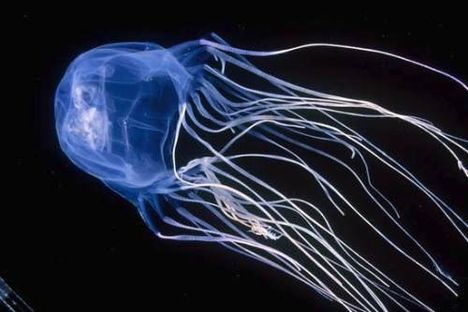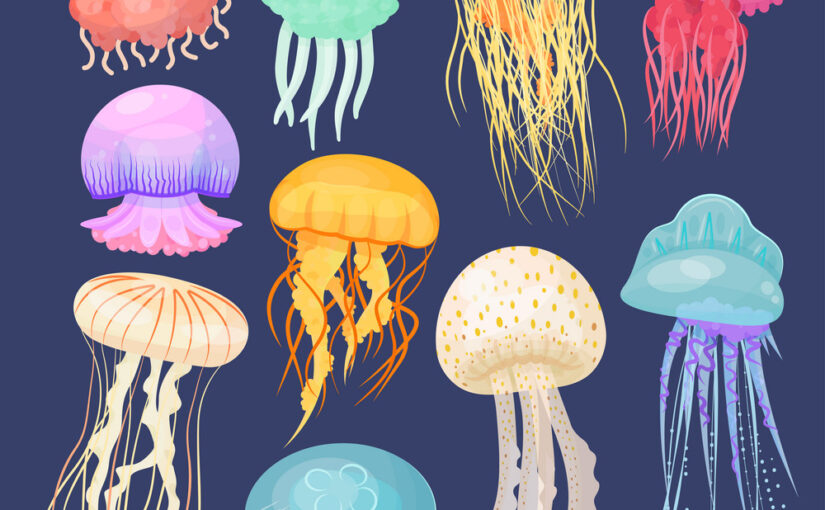Jellyfish Guide
Jellies commonly seen at Holden Beach
There are two types of jellyfish, or gelatinous zooplankton in North Carolina — true jellyfish and comb jellies, or ctenophores. True jellyfish pump water for propulsion by using the bell on top of their bodies to first contract and then relax their bodies to move water, hence pushing themselves forward in the water column. Comb jellies do not pump water to get around. Instead, they have eight rows of hair-like structures called cilia all around the outside of their bodies. By moving the cilia in a wavelike pattern, they slowly move through the water column.
Jellyfish are not really fish, of course, because a fish’s anatomy is centered around its backbone, whereas the jellyfish is a dome-shaped invertebrate. Therefore, it’s more accurate to refer to them simply as “jellies.” Believe it or not, these roving creatures, with their umbrella shape and hanging tentacles, are most closely related to corals , sea anemones, sea whips, and hydrozoans. Why? They share a distinctive body part – a harpoon-like stinging cell used to capture prey. Generally, these cells are called cnidocytes (hint: don’t pronounce the “c”), which comes from the ancient Greek word for nettle. Therefore, animals in this phylum are called cnidarians. The cnidocytes on jellies’ tentacles discharge venom from a sac called a nematocyst. These help them to capture floating prey in the water column. Jellies have limited control over their movement, using a muscle to propel themselves short distances by expanding and contracting their bell. Therefore, they drift in currents and often appear in large masses called a “bloom,” a “swarm,” or a “smack.” Purists consider the only “true jellies” to be members of one specific class of cnidarians, but many similar looking animals with dangling tentacles are referred to as jellyfish. For example, the Portuguese man o’ war is often mistaken for a type of jellyfish but is in fact a different type of cnidarian that inflicts a nasty sting. Comb jellies, despite the word “jelly” in their name, are not related to cnidarians. This is because they lack stinging cells, which makes them harmless to humans.
Often times beachgoers will spot jellyfish washed up on shore and other times they can be spotted in the water, but it is best to avoid them when you can. “While all jellyfish sting, not all contain poison that hurts humans. Be careful of jellies that wash up on shore, as some can still sting if tentacles are wet. NOAA recommends that if you are stung by a jellyfish to first seek a lifeguard to give first aid. If no lifeguards are present, wash the wound with vinegar or rubbing alcohol,” NOAA suggests. And what about that … other method of treating stings? Turns out, it’s a myth. In fact, urine can actually aggravate the stinging cells of jellyfish, making things worse. These cells, which detach and stick into the skin of prey, can continue to inject venom. Urine, as well as fresh water, can cause an imbalance to the salt solution surrounding the stinging cells, causing them to continue to fire. According to Scientific American, if you don’t have vinegar or rubbing alcohol, rinsing with salt water may be your best bet.
Cannonballs
The cannonball jellyfish (Stomolophus meleagris), also known as the cabbagehead jellyfish, is a species of jellyfish in the family Stomolophidae. Its common name derives from its similarity to a cannonball in shape and size. It is the most common jellyfish found in North Carolina. During summer and fall, large gatherings of this jelly take place near coastal areas and in the mouths of North Carolina estuaries. While this species is the most abundant jelly, it is also the least harmful to humans. It has the weakest sting of all jellies found in local waters. Easy to identify by their white bell with chocolate-brown bands, they have no tentacles, just fingerlike appendages hanging down from the bell.
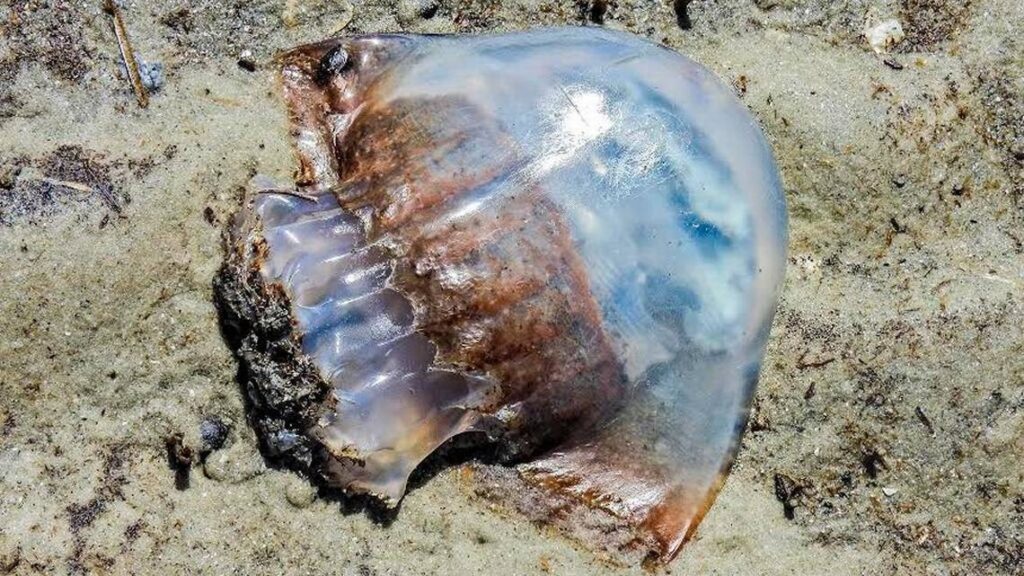
Lion’s Mane
The lion’s mane jellyfish (Cyanea capillata) is one the largest species in North Carolina waters. This species is easy to identify, as it is the only jellyfish that is orange in color. The bell, measuring 6-8 inches, is saucer-shaped with reddish-brown oral arms and eight clusters of tentacles hanging underneath. It usually appears during the colder months, this species is also known as the winter jelly, because it prefers the colder waters along the North Carolina coast after the Gulf Stream has moved farther offshore during winter months. Lion’s manes are usually considered moderate stingers, and symptoms of a sting are similar to that of a moon jelly, but with a little more discomfort. It is the largest known jellyfish species in the world. Its name was inspired by its showy, trailing tentacles that resemble an African lion’s mane. The lion’s mane uses its stinging tentacles to capture, pull in and eat with a diet of fish and smaller jellyfish that get too close to the tentacles. Its nematocysts, or stinging cells, are not known to be fatal to humans, pain from stings is relatively mild and often described as burning rather than stinging.
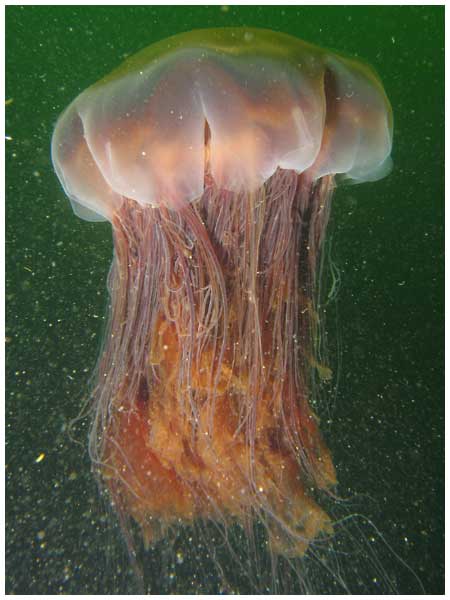
Moon jellies
The Moon jellies (Aurelia aurita) is one of the more otherworldly jellyfish is the moon jellyfish. These look like underwater flying saucers. Moon jellyfish are most common during the summer months from early June to September. This translucent species averages about 6 to 8 inches in diameter at the saucer-shaped bell. They have 4 horseshoe-shaped gonads in the center of the bell and short tentacles. It feeds by collecting medusae, plankton and mollusks with their tentacles and bring the food back into their body for digestion. They are only able to move slightly by themselves and rely more on ocean currents even when swimming by pulsing and relaxing their bell. Moon jellies breathe oxygen from surrounding waters by way of a thin membrane that covers the tops of their bodies.

Mushroom Cap
The Mushroom Cap jellies (Rhopilema verrilli) are cnidarian invertebrates distinguished by their mushroom-shaped medusae. The species does not have any tentacles; however, they still have stinging cells, called nematocysts, within their bells, which can produce mild stings to humans. Mushroom jellies are commonly mistaken for cannonballs, but they lack the brown bands of the cannonball. According to the Virginia Institute of Marine Science, the mushroom jelly has a firm and dense swimming bell, however its bell is usually flatter than that of the cannonball. The bell does have finger-shaped arms that grow down from the center.
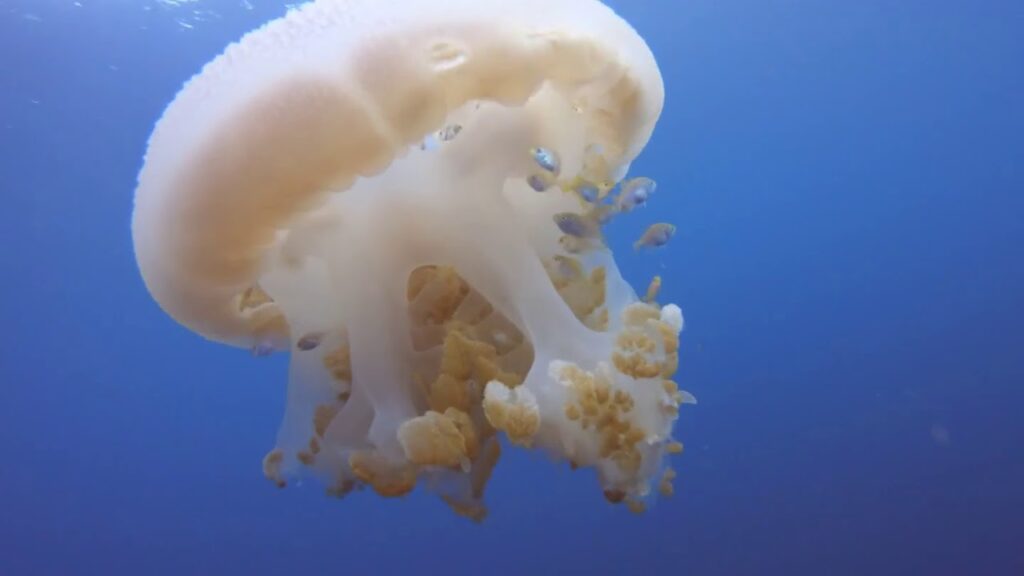
Portuguese man o’ war
The man-of-War are not usually in the area unless pushed to the coast by wind and ocean currents. It is a purple-blue color and can be up to 10 inches long. The Portuguese man o’ war (Physalia physalis), is not a jellyfish but related to the species and is highly venomous. It has numerous venomous microscopic nematocysts which deliver a painful sting powerful enough to kill fish. Stings can result in intense joint and muscle pain, headaches, shock, collapse, faintness, hysteria, chills, fever, nausea, and vomiting. Severe stings can occur even when the animal is beached or dead. Although it superficially resembles a jellyfish, the Portuguese man o’ war is in fact a siphonophore. Like all siphonophores, it is a colonial organism, made up of many smaller units called zooids. All zooids in a colony are genetically identical, but fulfill specialized functions such as feeding and reproduction, and together allow the colony to operate as a single individual.
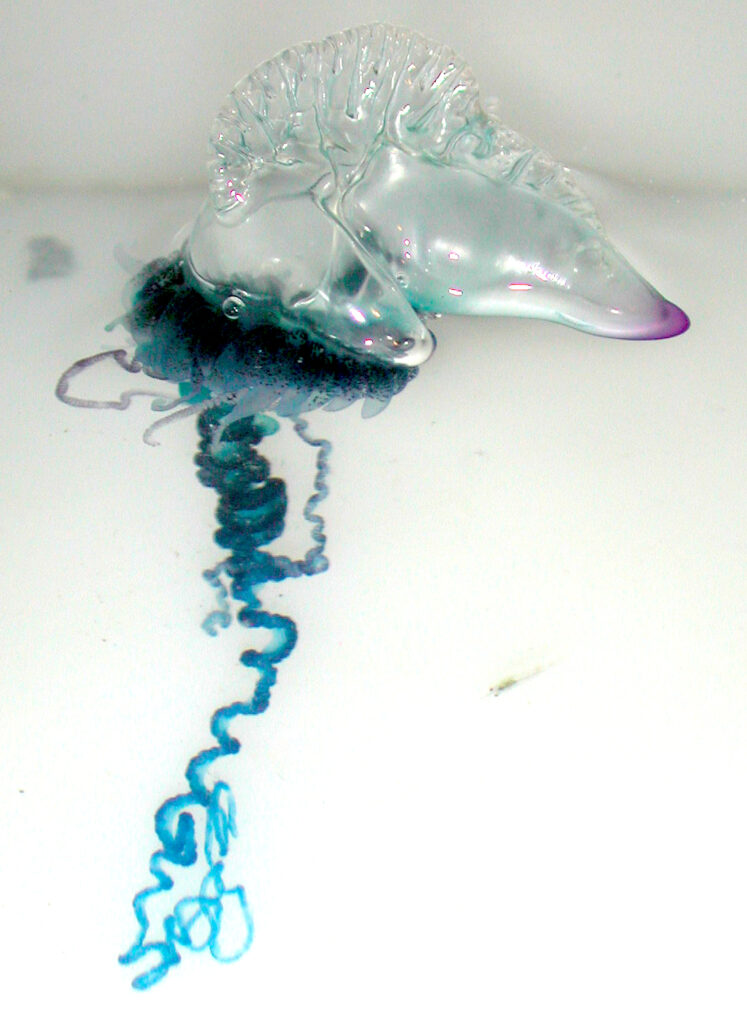
Sea Nettle
The Atlantic sea nettle (Chrysaora quinquecirrha) is a species of jellyfish that inhabits the Atlantic coast of the United States. Sea nettles are quite common and is the second-largest jellyfish. This species is semitransparent, saucer-shaped, and 6-8 inches in diameter with small white dots and reddish-brown stripes. They often appear in summer months and their stings can be moderate to severe. Sea Nettle’s cause most of the jellyfish stings in the state.
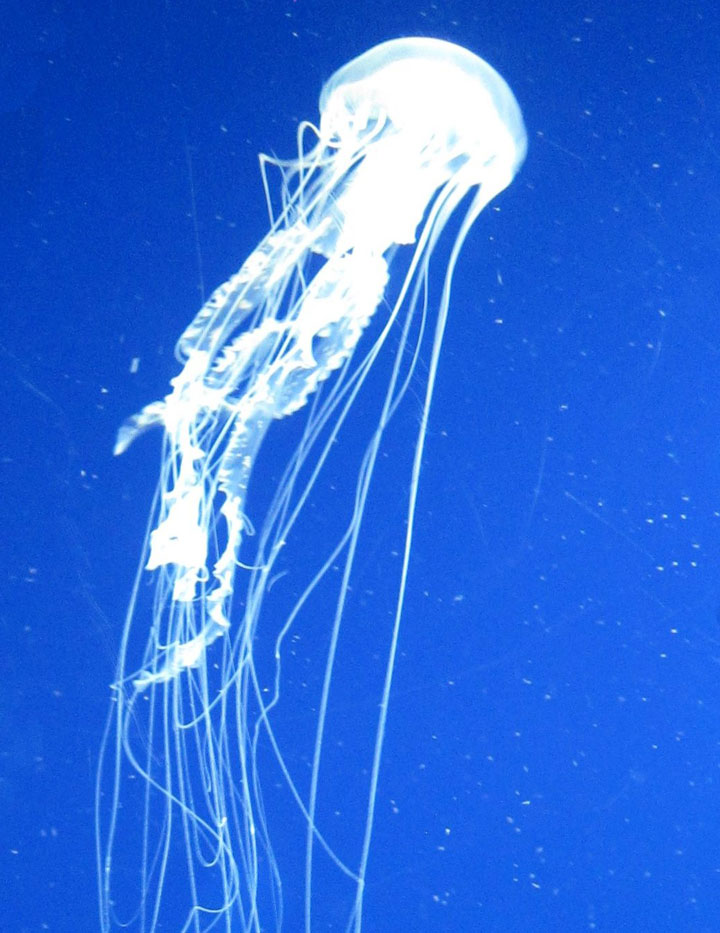
Sea Wasps
Sea Wasps (Chironex fleckeri) is a species of extremely venomous box jellyfish found in coastal waters. The jelly is also called the box jelly because of its cube-shaped bell. They are 5-6 inches in diameter and 4-6 inches in height. Notorious for its sting, C. fleckeri has tentacles up to 3 m (10 ft) long covered with millions of cnidocytes which, on contact, release microscopic darts delivering an extremely powerful venom. The sea wasp jelly is the most dangerous to humans, and the most venomous of all true jellies found in North Carolina waters. Being stung commonly results in excruciating pain followed by a severe skin rash. A sting may lead to a trip to the hospital, depending on the reaction severity. If stung in the face or neck area, it’s best to seek medical help as soon as is possible.
